The first true Historical Sew Fortnightly Challenge of the year (due 15 Jan) is Bi/Tri/Quadri/Quin/Sex/
Obviously people don’t throw away their clothes at the end of every year (as I write this I’m wearing a T-shirt that is at least 4 years old, and a pair of shorts that I bought at an op-shop and could be a decade old), and it’s hard to date historical garments to a precise year, so what you really want to do is make something that would be worn in 1813 (or 913, or 1613) without looking too outdated. If your item would have been worn by someone poor, it could be quite a few years earlier, if it’s a Paris ballgown, it should be very close to the date.
I’m making a dress based on a 1812 fashion plate – it’s a wool dress, so I presume it would have been worn during the winter, and would have been quite appropriate in January 1813. I’m so excited about it. I can’t wait to show you my progress!
If you haven’t picked a project, or just want to drool at some pretty pictures, here is some inspiration:
For AD 13, take inspiration from the frescoes at Pompeii, which were made in the decades before the town was destroyed in AD 64:
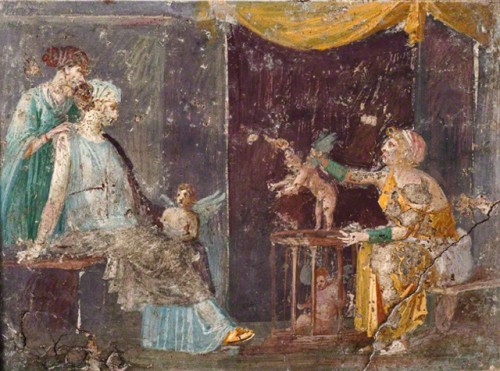
The Cupid Seller – fresco from Pompeii, now at the Getty
Wouldn’t the gold cap worn by the young woman (often referred to as Sappho) be a wonderful project?
For 1313, make a simple Medieval frock like one of these:

Two examples of women’s dress in the early 1300s, on the right is Margurite d’Artois from her tomb carving, 1311
For 1413, be inspired by the Golden Gown of Queen Margaret (the Uppsala Gown) – Carbon-14 dating has shown that the cloth was very probably woven during the period 1403-1439. There is plenty of research and sketches of the pattern shapes available on the internet, and images of the beautiful reproduction on display in the Historiska Museet in Stockholm.
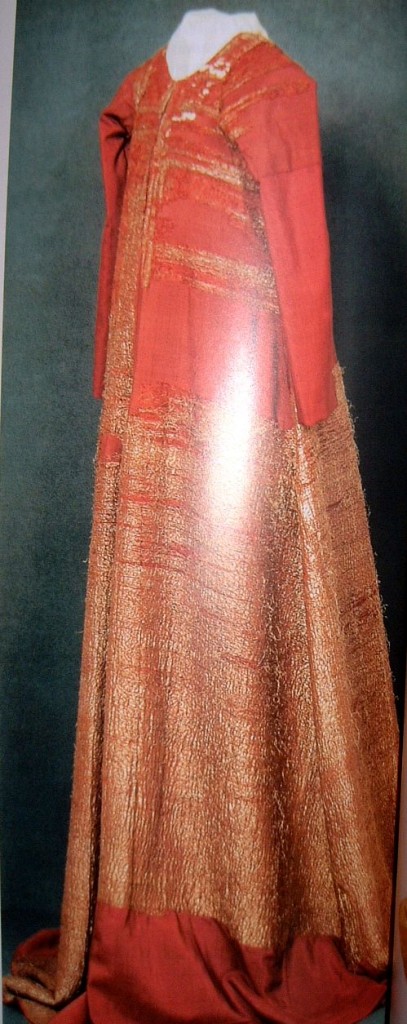
Gown of Italian gold brocade with a pomegranate design in gold on a reddish-violet silk ground. First half of the 15th century.
For 1513, no one wants to look like the Ugly Duchess (the poor woman probably suffered from Paget’s disease), but her headdress and bodice are quite magnificent, and meticulously rendered.
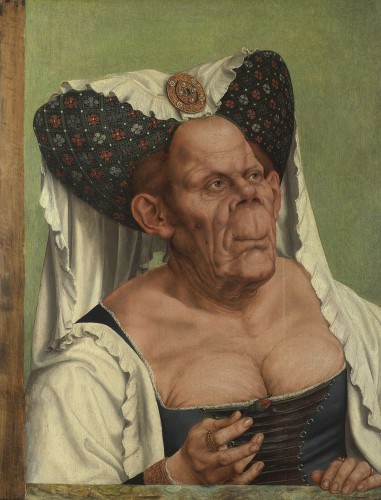
Quinten Massys (South Netherlandish, 1466-1530). An Old Woman (The Ugly Duchess), ca. 1513, National Portrait Gallery, London
For 1613, this striking jacket is actually quite simple in cut. What makes it so special is that there is a painting of the jacket being worn some 10 years after it was made. It’s been updated for the painting and the change in styles with the addition of silver-gilt trim, and by wearing the skirt over the jacket to achieve the new higher waistline.

Jacket, English, 1610-1615 (made), 1620 (altered), Linen, embroidered with coloured silks, silver and silver-gilt thread, V&A
For s, not every creation needs to be a full dress. These delightful shoes date to between 1700 and 1715. There are various ways you could try to replicate them. Start with a pair of American Duchess Pompadour shoes and add gilt lace and sequins, or use the free tutorial on Your Wardrobe Unlock’d to re-make a pair of modern shoes in 18th century style.
For 1813, you can’t beat a classic white Regency frock, this one in white satin with a magnificent Kashmiri shawl.
Finally, for 1913 why not make yourself a spectacular muff, or the equally fabulous dress it’s being worn with? Or, if you need more inspiration from this era, I have an entire pinterest page.

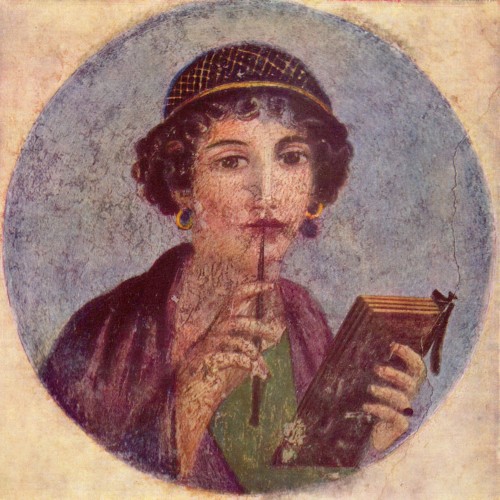
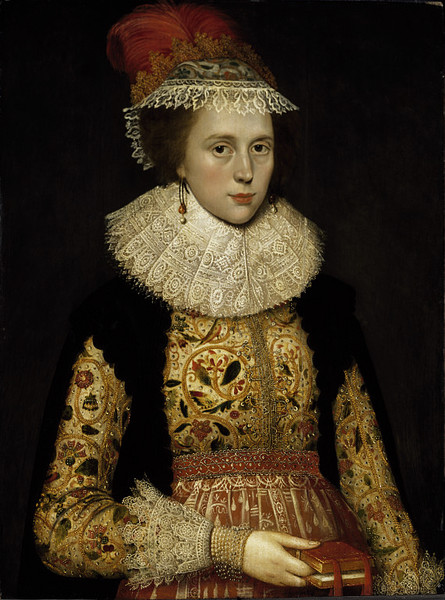
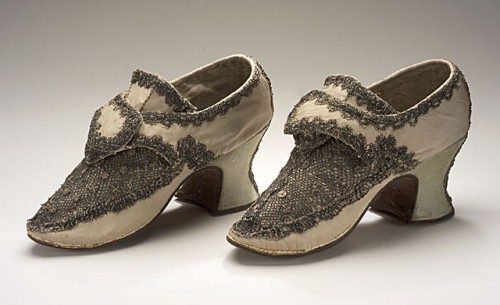

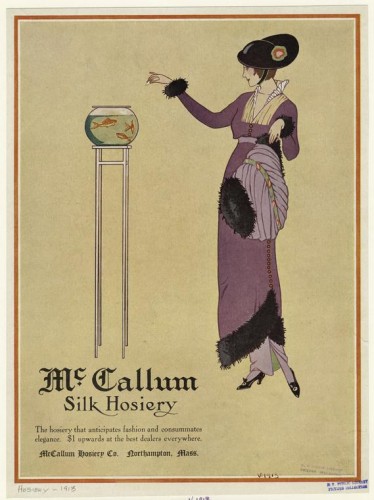
What a lovely spread if inspiration!
I like 1713: it doesn’t have to be a dress! I’m thinking bonnet. A bonnet is a good pick-me-up for New England winter.
Now that’s some great inspiration. This is one of the challenges I may not be able to do, but I do agree Sappho’s cap would be a great project. Oh well, can’t hurt to do a little research…
Hehe…temptation. My work here is done 😉
My work, however, is only beginning. I didn’t have gold thread so I went for indigo dye. now I have blue fingers and the cat is looking at me in a funny way. I told her it’s your fault, but she’s not buying it. She knows me too well.
I liked seeing all the different eras, some of which I’ve done over the years with my kids! I especially liked your 1613 jacket/painting combo.
Laurie
I had a look at the pinterest page you linked to, it’s lovely but pretty much all evening gowns. You’ve got to wonder why no-one put the every day stuff in the museum collections as well, though I guess they’d be much more worn and also worked over as well.
I didn’t get any sewing done tonight, but have decided all my seams will need to be bound so the wool doesn’t fray, the overlocker somehow seems wrong for this project.
It’s pretty much all evening gowns because it is all evening gowns 😉 I’ve got a page for general 1910s wear as well that has a lot more daywear, but that one was more specific 1910-13, and evening wear.
I’ve been binding all my seams too – wool twill is a pain.
Ok–was I the only one who spit out her coffee at The Dreamstress writing “SEX” in big letters?
For real, this sounds wonderful. It will be fun to see what you all come up with. Also, is it just me, or are all fashions always so much prettier at the beginning of a century than the end?
Happy New Year!
You have a juvenile mind Elise!
I’m not sure I agree with the fashions are prettier at the beginning of a century theory. I like end-of-18th century fashions a bit more than early 18th century fashions, and late 17th century fashions are pretty much a million and a half times better than early 17th century fashions.
Ok, the mind stopped counting backward from 1913 to 1813 to 1713 when I the brain took over doing the backward dance from 30-years-old to 13-years-old.
Haha!
I’m afraid I won’t be joining you on this one, having only one time period I really costume for – 1370, England. However, if nothing else I shall attempt to do the Peasants & Pioneers one – I almost always prefer to make and wear lower class clothes. For one, you never need worry about cooking, camping, gathering firewood, chasing children/dogs/farm animals, etc., etc., etc.